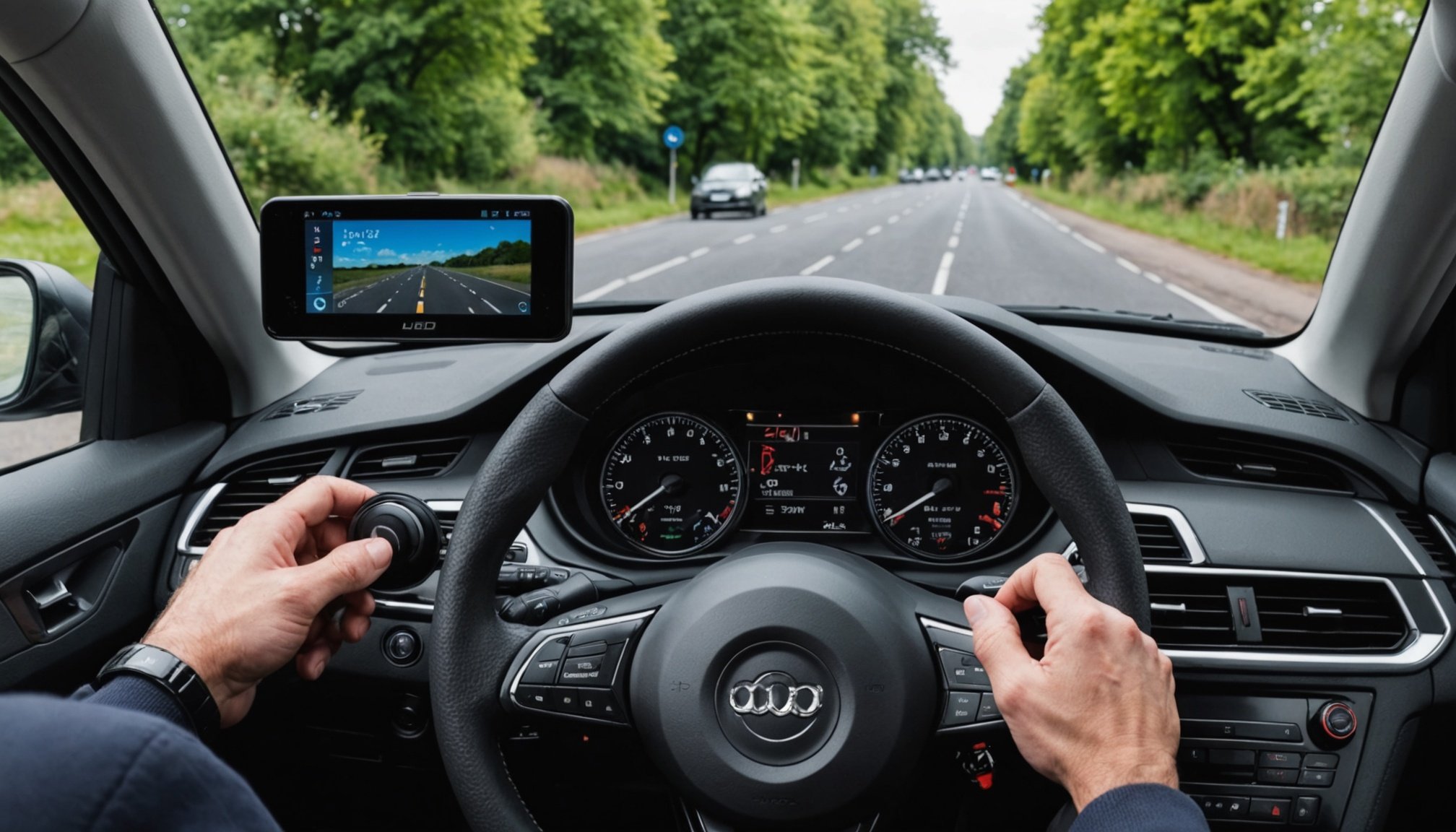Overview of Heads-Up Displays (HUD)
Heads-up displays (HUDs) offer significant benefits by integrating critical information into the driver’s line of sight, enhancing vehicle safety features. Primarily, HUD technology projects key data such as speed, navigation instructions, and alerts directly onto the windscreen. This allows drivers to access essential details without the need to shift their focus away from the road, thus contributing to a safer driving experience.
The advantages of installing a HUD in vehicles are manifold. It reduces the risk of distractions, keeps the driver’s attention on the road, and can be especially helpful in low-visibility conditions. By having data readily available at a glance, drivers can make informed decisions more quickly.
Additional reading : Perfect your headlight alignment: boost your uk car’s visibility in foggy conditions
HUD technology has seen substantial developments within the automotive industry. Initially designed for military use, it has evolved into a sophisticated tool available for consumer vehicles. Advances have led to more integrated HUD systems, providing seamless connectivity with smartphones and in-car infotainment systems. With ongoing innovations, HUDs are expected to incorporate augmented reality elements, further enhancing the driving experience. As automotive technology progresses, HUD installations in consumer vehicles are becoming increasingly common, blending tech-savvy convenience with practicality.
Preparing for Installation
Installing a heads-up display (HUD) requires precise preparation to ensure a smooth setup process. One crucial step is to gather all the essential tools needed for the installation, which typically include screwdrivers, wire strippers, and a multimeter for testing electrical connections. Having the right tools on hand facilitates a more efficient installation and reduces the likelihood of errors.
Topic to read : The complete handbook for safely installing rear-facing baby car seats in uk vehicles
Before proceeding with the installation, it’s important to assess the vehicle compatibility with different HUD types. Not all HUDs are universally compatible; some require specific display surfaces or proprietary connectors. Checking the vehicle’s make and model will ensure you select a HUD that integrates seamlessly with your car’s existing systems.
Pre-installation checks are another vital component of a successful HUD installation. This involves examining the vehicle’s dashboard and windscreen to determine the optimal positioning for the display. Verifying that the location is free of obstructions and that the dashboard can support the HUD is essential. Additionally, it’s wise to review the vehicle’s manual for any specific instructions or warnings regarding the integration of third-party electronic devices. By following these steps, you are preparing your vehicle for an efficient and problem-free HUD installation.
Step-by-Step Installation Guide
Embarking on the journey to install a heads-up display (HUD) requires a structured approach to ensure success. This guide will lead you through the essential steps, enabling a seamless setup process.
Understanding the Wiring Process
A crucial element is accurately wiring the HUD system. Start by identifying your vehicle’s fuse box and locating an appropriate circuit for the HUD connection. Use a circuit tester to identify the right fuse line for uninterrupted power. Refer to your HUD’s installation manual for specific wiring instructions, ensuring each wire is connected in alignment with the car’s electrical system. Proper wiring is essential to prevent electrical issues and ensure reliable HUD functionality.
Mounting the Heads-Up Display
Positioning the display is key for optimal visibility. Select an area on the dashboard that offers a clear line of sight without obstructing your view of the road. Ensure the surface is clean and dry before securing the HUD with mounting adhesives or brackets provided. It’s essential that the HUD remains stable during operation, to maintain readability.
Connecting the Power Source
Finally, connect the HUD to the chosen power source, ensuring the connection is secure. It’s advisable to switch off the vehicle’s ignition during this process to avoid electrical hazards. With all connections verified, test the HUD to ensure it’s functioning properly before starting your journey.
Troubleshooting Common Issues
When dealing with HUD troubleshooting, recognizing typical installation challenges can ease the process. A frequent issue is improper wiring resulting in a non-functional display. To resolve this, ensure that all electrical connections are secure and verify that the chosen fuse provides consistent power. Incorrect wiring can lead to system failures, risking the HUD’s effectiveness.
Another prevalent problem is dim or fading displays, often due to poor placement or incorrect calibration. If the display fading persists, consider repositioning the HUD to a more visible location or adjusting the brightness settings according to ambient light conditions. Ensuring the surface is clean and free from glare-inducing obstructions also enhances visibility.
Connectivity glitches, such as the HUD not syncing with the vehicle’s systems, can cause frustration. Confirm that the HUD software is up-to-date and compatible with your car’s technology. Consulting the installation manual for specific problem-solving tips related to interfaces and updates is beneficial.
Addressing these common issues promptly helps maintain the HUD’s functionality and sustains the enhanced driving experience it provides. Implementing these solutions ensures your heads-up display operates effectively, offering critical information reliably on every journey.
Safety Precautions
Ensuring safety during HUD installation is crucial, especially when working with vehicle electronics. Begin by reviewing your car’s manual to understand the electrical system and avoid mishaps. Disconnect the battery before starting to prevent any unintended power surges. This reduces the risk of electric shock or accidental short circuits.
Guidelines for tool usage stress the importance of using insulated tools when working near live circuits. Always ensure your workspace is well-lit and organised to prevent accidents. Keeping hardware such as screws and brackets secure prevents losing vital components during the process.
To avoid electrical hazards, double-check all connections. A faulty connection can not only harm the HUD but may also impact the overall vehicle system. Test each wire connection with a multimeter to ensure proper current flow before finalising the installation.
It’s also advisable to wear protective gear like safety goggles and gloves to safeguard against unexpected sparks or debris. Awareness and adherence to these safety measures ensure a smooth, incident-free HUD installation, safeguarding both your vehicle and personal well-being. Besides enhancing installation efficiency, these precautions contribute to the long-term effectiveness and durability of the installed technology.
Visual Aids and Resources
To complement your HUD installation process, employing visual aids and resources is invaluable. These tools enhance understanding, ensuring a more efficient and error-free setup.
Utilizing HUD Installation Videos
HUD installation videos serve as practical visual guides. These resources demonstrate step-by-step processes, offering insights into the nuances of wiring and mounting a HUD. By observing exact procedures and techniques, users can gain a clearer perspective, minimising potential errors during installation.
Importance of Image Guides
Image guides provide static references, detailing crucial aspects of the installation. These guides illustrate the precise locations of key components, enhancing clarity and aiding in the proper alignment and positioning of the HUD. Such detailed images ensure you correctly connect wires and secure fixtures with confidence.
Access to Installation Manuals
Installation manuals are comprehensive resources, offering specific instructions tailored to various vehicle models. They offer insights into vehicle compatibility, detailing any unique requirements or potential challenges. By thoroughly consulting these manuals, you ensure the installation adheres to the manufacturer’s guidelines, maintaining overall system integrity and functionality. These resources collectively contribute to a more informed, streamlined HUD installation experience.
Frequently Asked Questions (FAQs)
Understanding common concerns regarding heads-up displays (HUDs) is crucial for users considering installation. Here, we address frequently asked questions about HUD performance, safety, and legality in the UK.
Is installing a HUD legal in the UK? Yes, HUDs are legal as long as they do not obstruct the driver’s view. These devices are designed to improve vehicle safety features by projecting information without distraction, aligning with road safety regulations.
Will installing a HUD void my car’s warranty? Generally, adding a HUD should not void your vehicle warranty unless the installation causes damage. Ensure a professional setup adheres to manufacturer guidelines to maintain warranty validity.
How does a HUD enhance driving safety? A HUD reduces distractions by displaying crucial data like speed and navigation directly in the driver’s line of sight. This means drivers spend less time diverting attention from the road, thereby enhancing vehicle safety features incrementally.
Are there concerns about HUD performance during the night? Modern HUD systems are designed to adjust brightness automatically based on ambient light. Nonetheless, verify the HUD’s specifications to ensure optimal performance in both daytime and low-light conditions.











